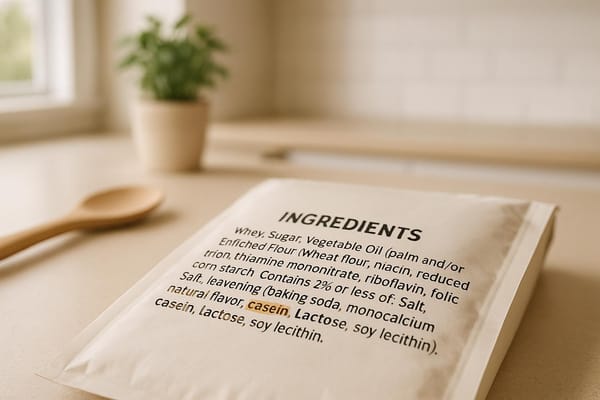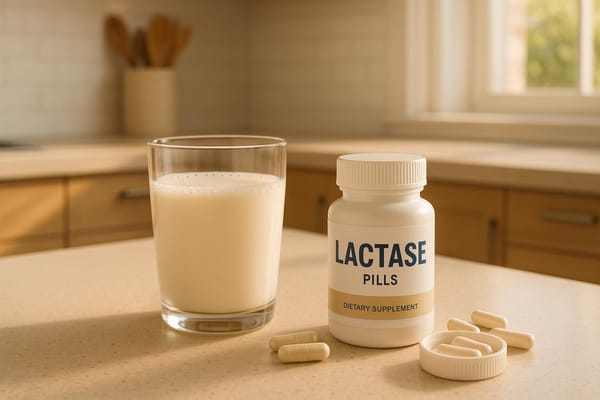Daily Vitamin D Needs for Lactose Intolerant Adults
Learn how lactose intolerant adults can meet their vitamin D needs through diet, sun exposure, and supplements for better health.

Struggling to get enough vitamin D without dairy? Adults with lactose intolerance often face challenges meeting their daily vitamin D needs, which are essential for strong bones, immune health, and mood regulation. Here's what you need to know:
-
Daily Vitamin D Requirements:
- Ages 19–70: 600 IU (15 mcg)
- Ages 70+: 800 IU (20 mcg)
-
Non-Dairy Vitamin D Sources:
- Foods: Wild-caught salmon (500–1,000 IU/serving), canned tuna (236 IU), fortified plant milks (100–144 IU), and more.
- Sunlight: Aim for 10–30 minutes of midday sun exposure 2–3 times per week, depending on skin tone.
- Supplements: Vitamin D3 (1,000–2,000 IU daily) is recommended for most people, with higher doses for deficiencies under a doctor’s guidance.
- Lactase Enzyme Supplements: Products like milktab can help you digest dairy and access its vitamin D content.
Regularly testing your vitamin D levels (ideally 30–50 ng/mL) and combining sun exposure, fortified foods, and supplements can help you maintain healthy levels without dairy.
How to get calcium and vitamin D without dairy
How Vitamin D Works in the Body
Vitamin D plays a key role in helping the body absorb calcium efficiently and maintaining healthy bones and muscles. It ensures calcium from food is absorbed and helps regulate the balance between bone building and breakdown. This is especially important for individuals who avoid dairy products due to lactose intolerance.
Lactose Intolerance and Vitamin D Deficiency Risk
For those with lactose intolerance, avoiding fortified dairy products can lead to a lower intake of vitamin D. Many lactose-intolerant adults miss out on this nutrient when they skip dairy. Using lactase supplements, such as milktab, can help digest dairy and provide access to this important nutrient.
Health Effects of Low Vitamin D
A deficiency in vitamin D can lead to several health problems, including:
- Weakened bones, which increases the risk of fractures
- Reduced muscle function, making falls more likely
- Compromised immune response, leading to a higher chance of infections
Getting enough vitamin D is crucial for proper calcium absorption and utilization, supporting bone strength and overall health.
Required Daily Vitamin D Amounts
Getting enough vitamin D is especially important for lactose intolerant adults to maintain their health.
Standard Daily Requirements
In the U.S., adults aged 19–70 are advised to consume 600 IU (15 mcg) of vitamin D daily. For those over 70, the recommended intake increases to 800 IU (20 mcg). These amounts are key for supporting bone health and immune function.
| Age Group | Daily Vitamin D Requirement |
|---|---|
| Adults 19–70 | 600 IU (15 mcg) |
| Adults 70+ | 800 IU (20 mcg) |
Lactose intolerant individuals may need to take extra steps to meet these recommendations.
Tips for Lactose Intolerant Adults
Here are some practical ways to meet vitamin D needs without relying on traditional dairy:
- Fortified non-dairy products: Look for foods like fortified orange juice, cereals, and plant-based milks that are enriched with vitamin D.
- Use lactase supplements: Products like milktab can help digest dairy, allowing you to benefit from its vitamin D content.
- Combine multiple sources: Balance your intake with a mix of sun exposure, fortified foods, supplements, and limited dairy consumption (with the help of lactase).
Your specific needs may depend on factors like skin tone, geographic location, diet, and overall health. Regularly checking your vitamin D levels can help ensure you’re on track.
Getting Vitamin D Without Dairy
If you're lactose intolerant, you can still meet your daily vitamin D needs through non-dairy sources.
Food Sources
Plenty of non-dairy foods naturally contain vitamin D or are fortified with it. Here's a quick breakdown:
| Food Source | Vitamin D Content (per serving) |
|---|---|
| Wild-caught salmon (3.5 oz) | 500-1,000 IU |
| Mackerel (3.5 oz) | 450 IU |
| Canned tuna (3.5 oz) | 236 IU |
| Egg yolks (1 large) | 40 IU |
| Fortified orange juice (8 oz) | 100 IU |
| Fortified plant milk (8 oz) | 100-144 IU |
| Fortified breakfast cereals (1 cup) | 80-100 IU |
Fortified plant-based options can provide vitamin D levels similar to dairy products. Be sure to check the nutrition labels, as the vitamin D content can vary by brand.
Pair these dietary sources with safe sun exposure to further support your vitamin D intake.
Sun Exposure Guidelines
Sunlight is the most effective way for your body to produce vitamin D. However, it's important to balance sun exposure and skin protection.
General exposure recommendations:
- Light skin: 10-15 minutes of midday sun
- Medium skin: 15-20 minutes of midday sun
- Dark skin: 20-30 minutes of midday sun
Aim for this exposure 2-3 times a week without sunscreen initially. Several factors can influence how much vitamin D your skin produces:
- Location: People living above 37° latitude (e.g., north of San Francisco or Richmond, VA) may get limited UVB exposure during winter months (November through March).
- Time of day: UVB rays are strongest between 10 AM and 3 PM.
- Season: Summer months are the most efficient for vitamin D production.
- Cloud cover: Clouds can block up to 50% or more of UVB rays.
After your recommended sun exposure, apply sunscreen with SPF 30 or higher to protect your skin.
Vitamin D Supplements
Signs You Might Need Them
Certain factors can indicate a need for vitamin D supplements, especially if you're lactose intolerant. Here are some common signs:
- Limited sun exposure: Spending most of your time indoors during daylight hours or living in northern areas with less sunlight.
- Darker skin tone: Higher melanin levels can reduce your skin's ability to produce vitamin D from sunlight.
- Age over 50: Aging skin becomes less efficient at synthesizing vitamin D.
- Higher BMI: Excess body fat can trap vitamin D, making it less available for your body to use.
- Digestive problems: Issues like celiac disease or Crohn's can interfere with nutrient absorption.
- Bone or muscle pain: These could be linked to a deficiency.
- Seasonal depression: Often connected to lower vitamin D levels during darker months.
If you notice these signs, it might be time to consider a supplement. Here's how to choose the right one.
Choosing the Right Vitamin D Supplement
Once you've identified a potential deficiency, follow these tips to pick an effective supplement.
Choosing the Right Type and Dose
- Opt for vitamin D3 (cholecalciferol) instead of D2, as it’s absorbed more efficiently.
- For general maintenance, start with 1,000–2,000 IU daily.
- If you have a severe deficiency, higher doses (4,000–5,000 IU) may be necessary, but only under a doctor’s guidance.
What to Look For
- Products with third-party certifications like USP or NSF to ensure quality.
- Clear and accurate dosage information on the label.
- Allergen-free options if you have sensitivities.
- Gelatin-free supplements if you're vegetarian or vegan.
Storage and Absorption Tips
- Store your supplements in a cool, dry place, away from direct sunlight.
- Take them with a meal containing some fat to improve absorption.
- Check expiration dates to ensure potency.
- If you have trouble swallowing pills, consider liquid forms for easier absorption.
Managing Your Vitamin D Levels
Keeping your vitamin D levels in check is especially important if you're lactose intolerant. A mix of regular testing and smart dietary choices can help you maintain healthy levels.
Blood Level Testing
To track your vitamin D levels effectively, consider the following:
- Frequency: Test every 6–12 months, or more often if you're managing a deficiency.
- Ideal range: Aim for 30–50 nanograms per milliliter (ng/mL).
- Test type: Use a 25-hydroxy vitamin D test.
- Timing: Test during the same season each year to account for natural changes.
Your healthcare provider can help interpret your results and guide you on any necessary supplementation.
Using Lactase Enzymes for Dairy
For those with lactose intolerance, lactase enzymes can make it easier to consume dairy products, which are often fortified with vitamin D. A product like milktab is a reliable option for supplementing lactase enzymes.
Here’s how to use lactase supplements effectively:
- Take the enzyme supplement right before eating or drinking dairy.
- Choose dairy products fortified with vitamin D to get the most benefit.
These steps can help you safely include more vitamin D-rich foods in your diet.
Summary
This section highlights key strategies to help lactose-intolerant individuals maintain healthy vitamin D levels.
Keeping vitamin D levels in check is especially important for adults with lactose intolerance. Achieving this balance involves regular testing and thoughtful dietary adjustments.
For those unable to consume dairy comfortably, lactase enzyme supplements can make a big difference. Here are three essential steps:
- Regular Testing: Check your vitamin D levels with 25-hydroxy tests every 6–12 months.
- Target Levels: Keep your levels within the 30–50 ng/mL range.
- Lactase Enzymes: Take lactase supplements before consuming fortified dairy products to make vitamin D more accessible.
Many people find that using enzyme supplements improves their ability to tolerate dairy, making it easier to incorporate vitamin D–fortified foods into their diet. Pairing this with regular testing and staying within the recommended range ensures better vitamin D management for those with lactose intolerance.
FAQs
What are some good sources of vitamin D for adults with lactose intolerance?
For adults with lactose intolerance, non-dairy sources of vitamin D can help meet daily needs. Some excellent options include fatty fish like salmon, mackerel, and tuna, as well as egg yolks. Certain fortified foods, such as plant-based milks (almond, soy, or oat), orange juice, and cereals, are also great choices. Spending time in sunlight can further boost your vitamin D levels naturally. If you're concerned about meeting your daily requirements, consult a healthcare provider about supplements or other strategies to maintain healthy levels.
How can adults with lactose intolerance meet their daily vitamin D needs through sun exposure?
Lactose intolerant adults can safely meet some of their vitamin D needs through sun exposure by spending about 10–30 minutes in direct sunlight several times a week, depending on skin tone, geographic location, and time of year. Exposing areas like the arms, legs, or face can help your body naturally produce vitamin D.
However, it’s important to balance sun exposure with skin protection to avoid overexposure and the risk of sunburn. If you have limited sun access or live in areas with low sunlight during certain seasons, consider vitamin D-rich foods or supplements to meet your daily requirements. Always consult a healthcare professional to determine the right approach for your needs.
How can adults with lactose intolerance meet their daily vitamin D needs, and when should they consider supplements?
Adults with lactose intolerance may struggle to get enough vitamin D, especially if they avoid fortified dairy products. Vitamin D is essential for bone health, immune support, and overall well-being. If you’re not getting enough through sunlight or diet, supplements can help.
Consider taking a vitamin D supplement if you have limited sun exposure, follow a dairy-free diet, or have been diagnosed with a deficiency. The recommended daily intake for most adults in the U.S. is 600–800 IU (International Units), but your healthcare provider may suggest a higher dose based on your specific needs. Always choose a supplement that meets quality standards and consult with a healthcare professional before starting any new regimen.



